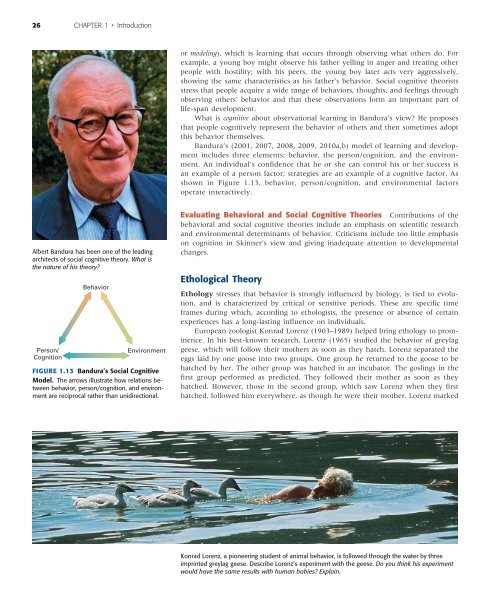Research in Life-Span Development
Research in Life-Span Development
Research in Life-Span Development
You also want an ePaper? Increase the reach of your titles
YUMPU automatically turns print PDFs into web optimized ePapers that Google loves.
26 CHAPTER 1 Introduction<br />
Albert Bandura has been one of the lead<strong>in</strong>g<br />
architects of social cognitive theory. What is<br />
the nature of his theory?<br />
Person/<br />
Cognition<br />
Behavior<br />
Environment<br />
FIGURE 1.13 Bandura’s Social Cognitive<br />
Model. The arrows illustrate how relations between<br />
behavior, person/cognition, and environment<br />
are reciprocal rather than unidirectional.<br />
or model<strong>in</strong>g ), which is learn<strong>in</strong>g that occurs through observ<strong>in</strong>g what others do. For<br />
example, a young boy might observe his father yell<strong>in</strong>g <strong>in</strong> anger and treat<strong>in</strong>g other<br />
people with hostility; with his peers, the young boy later acts very aggressively,<br />
show<strong>in</strong>g the same characteristics as his father’s behavior. Social cognitive theorists<br />
stress that people acquire a wide range of behaviors, thoughts, and feel<strong>in</strong>gs through<br />
observ<strong>in</strong>g others’ behavior and that these observations form an important part of<br />
life-span development.<br />
What is cognitive about observational learn<strong>in</strong>g <strong>in</strong> Bandura’s view? He proposes<br />
that people cognitively represent the behavior of others and then sometimes adopt<br />
this behavior themselves.<br />
Bandura’s (2001, 2007, 2008, 2009, 2010a,b) model of learn<strong>in</strong>g and development<br />
<strong>in</strong>cludes three elements: behavior, the person/cognition, and the environment.<br />
An <strong>in</strong>dividual’s confi dence that he or she can control his or her success is<br />
an example of a person factor; strategies are an example of a cognitive factor. As<br />
shown <strong>in</strong> Figure 1.13 , behavior, person/cognition, and environmental factors<br />
operate <strong>in</strong>teractively.<br />
Evaluat<strong>in</strong>g Behavioral and Social Cognitive Theories Contributions of the<br />
behavioral and social cognitive theories <strong>in</strong>clude an emphasis on scientifi c research<br />
and environmental determ<strong>in</strong>ants of behavior. Criticisms <strong>in</strong>clude too little emphasis<br />
on cognition <strong>in</strong> Sk<strong>in</strong>ner’s view and giv<strong>in</strong>g <strong>in</strong>adequate attention to developmental<br />
changes.<br />
Ethological Theory<br />
Ethology stresses that behavior is strongly <strong>in</strong>fl uenced by biology, is tied to evolution,<br />
and is characterized by critical or sensitive periods. These are specifi c time<br />
frames dur<strong>in</strong>g which, accord<strong>in</strong>g to ethologists, the presence or absence of certa<strong>in</strong><br />
experiences has a long-last<strong>in</strong>g <strong>in</strong>fl uence on <strong>in</strong>dividuals.<br />
European zoologist Konrad Lorenz (1903–1989) helped br<strong>in</strong>g ethology to prom<strong>in</strong>ence.<br />
In his best-known research, Lorenz (1965) studied the behavior of greylag<br />
geese, which will follow their mothers as soon as they hatch. Lorenz separated the<br />
eggs laid by one goose <strong>in</strong>to two groups. One group he returned to the goose to be<br />
hatched by her. The other group was hatched <strong>in</strong> an <strong>in</strong>cubator. The gosl<strong>in</strong>gs <strong>in</strong> the<br />
fi rst group performed as predicted. They followed their mother as soon as they<br />
hatched. However, those <strong>in</strong> the second group, which saw Lorenz when they fi rst<br />
hatched, followed him everywhere, as though he were their mother. Lorenz marked<br />
Konrad Lorenz, a pioneer<strong>in</strong>g student of animal behavior, is followed through the water by three<br />
impr<strong>in</strong>ted greylag geese. Describe Lorenz’s experiment with the geese. Do you th<strong>in</strong>k his experiment<br />
would have the same results with human babies? Expla<strong>in</strong>.

















